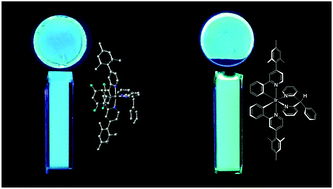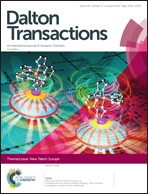Phosphorescent cationic iridium(iii) complexes bearing a nonconjugated six-membered chelating ancillary ligand: a strategy for tuning the emission towards the blue†
Abstract
This study concerns an assessment of the impact of the interruption of the electronic crosstalk between the pyridine rings in the ancillary ligand on the photoluminescence properties of the corresponding iridium(III) complexes. Two new cationic Ir(III) complexes, [Ir(dFmesppy)2(pmdp)]PF6, 1, and [Ir(mesppy)2(pmdp)]PF6, 2, [where dFmesppy is 2-(2,4-difluorophenyl)-4-mesitylpyridinato, mesppy is 4-mesityl-2-phenylpyridinato and pmdp is 2,2′-(phenylmethine)dipyridine, L1] possessing sterically congested cyclometalating ligands combined with the nonconjugated diimine ancillary N^N ligand are reported and their solution-state and thin film photophysical properties analyzed by both experimental and theoretical methods. The crystal structure of 1 confirms the formation of a six-membered chelate ring by the N^N ligand and illustrates the pseudo-axial configuration of the phenyl substituents. Upon photoexcitation in acetonitrile, both complexes exhibit a ligand-centered emission profile in the blue-green region of the visible spectrum. A significant blue-shift is observed in solution at room temperature compared to the analogous reference Ir(III) complexes (R1 and R2) bearing 4,4′-di-tert-butyl-2,2′-bipyridine (dtBubpy) as the N^N ligand. The computational investigation demonstrates that the HOMO is mainly centered on the metal and on both cyclometalating aryl rings of the C^N ligands, whereas the LUMO is principally localized on the pyridyl rings of the C^N ligands. The photoluminescence quantum yield is reduced compared to the reference complexes, a probable consequence of the greater flexibility of the ancillary ligand.

- This article is part of the themed collection: New Talent: Europe


 Please wait while we load your content...
Please wait while we load your content...